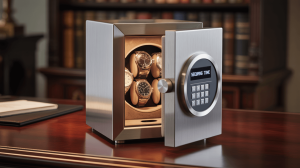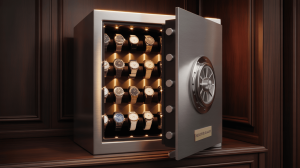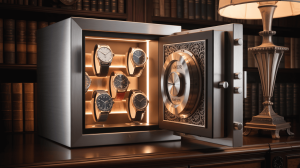The Unsung Hero of Your Luxury Timepiece
Imagine your finest automatic watch—a symphony of gears and springs—abandoned in darkness, its mechanics grinding to a halt. Every stagnant hour robs it of accuracy, while dried lubricants threaten its heartbeat. This is where a precision winder steps in: an elegant solution that breathes life into your collection, ensuring each piece remains as vibrant as the day you acquired it.
For connoisseurs, this device isn’t optional—it’s essential upkeep. It banishes the tedium of manual adjustments, protects delicate complications, and maintains peak performance. Picture your perpetual calendar or moon phase display flawlessly tracking time, as if worn daily. No guesswork. No wear from neglect. Just uninterrupted excellence.
From solo statement pieces to an entire arsenal of horology, mastering these tools elevates care from mundane to masterful. Ready to refine your routine? Let’s begin.
2. The Ingenious Mechanics Behind Self-Winding Timepieces
The Kinetic Symphony: Rotor, Mainspring, and Energy Reserve
At the heart of every self-winding timekeeper lies a marvel of mechanical artistry. A rotor—a semi-circular weight—swivels freely with the wearer’s motion, transferring energy through gears to coil the mainspring, the powerhouse storing kinetic force. This energy reserve, typically lasting 40–80 hours, fuels the gear train and escapement, ensuring uninterrupted precision.
Myth-Busting: Why “Overwinding” Is a Misconception
Modern mechanisms incorporate a slipping clutch (or “bridle”) that disengages the rotor once the mainspring reaches full tension. This failsafe renders overwinding impossible—a persistent fiction debunked by horological science.
Horology 101: Manual vs. Self-Winding vs. Quartz
- Manual: Requires daily crown winding; prized for tactile ritual.
- Self-Winding: Harnesses motion for autonomy; ideal for daily wear.
- Quartz: Battery-driven quartz crystal oscillation; unmatched accuracy but lacks mechanical soul.
Each type caters to distinct lifestyles, blending tradition, innovation, and personal preference.
3. Selecting the Perfect Timepiece Companion: A Buyer’s Guide
Single or Multi-Unit? Aligning Capacity with Your Collection
For owners of one prized mechanical piece, a dedicated single-unit offers compact efficiency and budget-friendly upkeep. Those with 3+ automatics should opt for modular systems (4-12 slots), which streamline winding while displaying collections like a curated exhibit. Pro tip: Ensure each compartment allows independent programming for mixed-brand collections.
Precision Engineering: TPD and Rotation Essentials
Most automatics require 650–1,200 turns daily (TPD), but high-complication pieces (e.g., perpetual calendars) may need 1,500+. Rotation direction varies:
- Unidirectional (clockwise/counterclockwise) for ETA 2824
- Bidirectional for Miyota 9015
Check manufacturer specs—an incorrect setting wastes energy without proper winding.
Silent Guardians: Noise, Power, and Material Considerations
- Acoustics: Japanese core motors operate below 15dB (whisper-quiet), while cheap models hum at 30dB+.
- Energy: AC-powered units suit home use; battery options (AA/Li-ion) enable travel readiness.
- Aesthetics: Walnut veneer or carbon fiber cases blend into studies; ABS plastic works for discreet storage.
Bonus: Smart Features for Discerning Owners
- LED-lit glass tops showcase pieces without UV damage
- Auto-sleep modes pause winding after 48hrs to conserve power
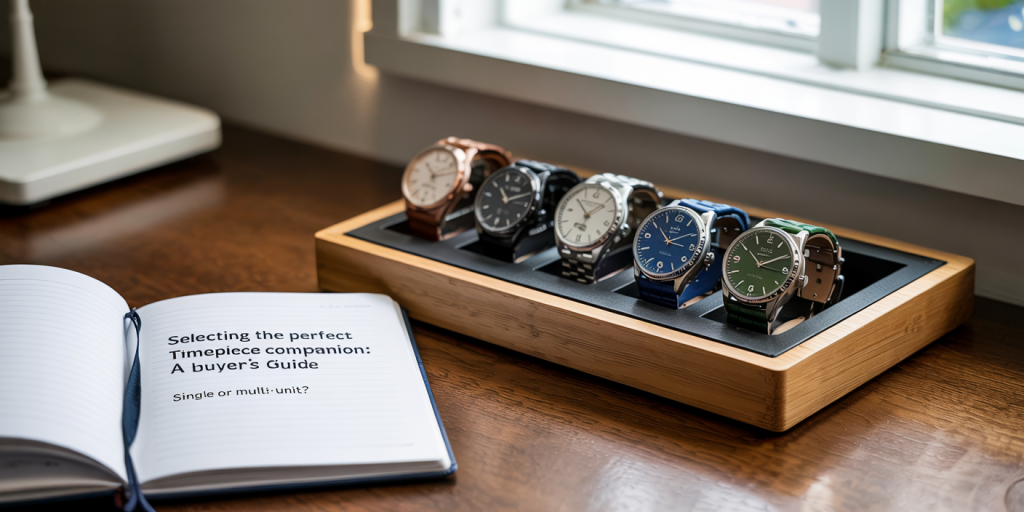
4. Mastering Your Timepiece Companion: A Setup Guide
Step 1: Unboxing & Quality Assurance
Carefully inspect the unit for transit damage, ensuring all components (cushions, power adapters, manuals) are present. High-end models often include anti-static foam and toolkits for assembly. Document any discrepancies for warranty claims.
Step 2: Power Activation & Energy Options
- AC vs. Battery: Plug-in models offer stability for home use; lithium-ion batteries suit travel.
- Troubleshooting: If unresponsive, check fuse compatibility or reset the circuit board (refer to brand-specific manuals).
Step 3: Customizing Motion Parameters
- TPD & Direction: Consult your timepiece’s manual—e.g., Rolex typically needs 650+ turns bidirectionally, while Omega may require unidirectional motion.
- Presets: Use pre-programmed modes for mainstream brands; opt for custom intervals for haute horology pieces like perpetual calendars.
Step 4: Safeguarding Your Horological Investment
- Placement: Center the watch on the cushion, ensuring the crown doesn’t contact the rotor.
- Strap Adjustment: Loosen bracelets slightly to prevent tension on lugs; leather straps benefit from periodic repositioning to avoid creasing.
5. Mastering Horological Preservation: Expert Winding Strategies
Tailoring Settings for Complex Mechanisms
High-complication pieces demand precision:
- Perpetual calendars: Require 1,800+ TPD (turns per day) with bidirectional motion to sync moonphases/leap years.
- Tourbillons: Opt for 650–900 TPD unidirectional to reduce strain on the escapement.
- Chronographs: Pause winding during long storage to preserve pusher mechanisms.
Orchestrating Multi-Watch Maintenance
For collections:
- Priority rotation: Assign winders to watches worn weekly; let others rest (e.g., 2 days winding, 5 days idle).
- Brand-specific grouping: Cluster watches by TPD/direction (e.g., Rolex/Patek share bidirectional 650 TPD).
- Smart scheduling: Use programmable units to stagger cycles, reducing simultaneous power draw.
When to Bypass Winding Altogether
- Vintage pieces: Pre-1980s movements lack modern lubricants; manual winding prevents rotor wear.
- Long-term storage: Drain power reserves fully to prevent lubricant degradation (store crown-up in silica gel cases).
- Quartz hybrids: Disengage winders for solar/kinetic models to avoid unnecessary gear friction.

6. Preserving Your Timepiece Companion: Essential Care Protocol
Interior & Exterior Maintenance
- Dust Control: Use a microfiber cloth lightly dampened with distilled water for surfaces. For stubborn grime, opt for pH-neutral cleaners—avoid alcohol or abrasives that degrade finishes.
- Deep Cleaning: Disconnect power and remove cushions to access hidden crevices. A soft brush (e.g., camel hair) dislodges debris from rotor mechanisms.
Mechanical Longevity: Lubrication Insights
- Targeted Care: Only lubricate hinges or rotating joints if specified in manuals (e.g., synthetic watch oil for metal gears). Over-application attracts dust.
- Motor Health: High-end units with sealed bearings rarely need lubrication; consult manufacturers before intervention.
Ideal Storage Conditions
- Climate Control: Store at 18–24°C with <60% humidity to prevent condensation or lubricant evaporation. Silica gel packs absorb excess moisture.
- Placement: Elevate on non-conductive surfaces (wood/acrylic) away from magnets or vents to shield electronics.
Pro Tip: Rotate inactive units monthly to prevent motor stagnation.
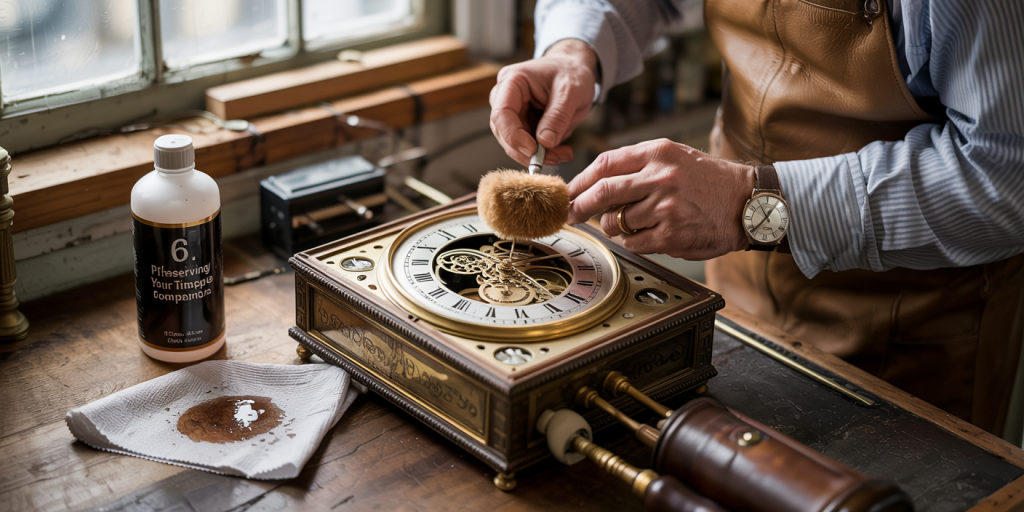
7. Resolving Timepiece Companion Malfunctions
Silent Stoppage: Diagnosing Power Failures
If your device halts despite activation:
- Motor Check: Listen for faint humming when powered—silence indicates motor failure.
- Voltage Test: Use a multimeter to verify AC adapters output correct voltage (typically 5V-12V DC).
- Battery Reset: For lithium-ion units, full discharge/recharge cycles can recalibrate power sensors.
Vibration & Acoustic Disturbances
For rattling or buzzing:
- Isolation Pads: Install rubber/silicone mounts beneath the unit to absorb 60% of vibrations.
- Rotor Alignment: Gently reposition misaligned cushions—off-center placement causes harmonic resonance.
- Professional Help: Seek repairs if noises persist after 48hrs, indicating bearing wear.
Optimizing Portable Power
Extend battery runtime by:
- Airplane Mode: Disabling unused LED displays saves 20% energy.
- Pulse Charging: Program intermittent winding (30min on/90min off) to triple alkaline battery life.
- Solar Hybrids: Pair with 5W USB solar panels for indefinite off-grid operation.
8. Safeguarding Your Horological Investment
Magnetic Field Defense
- Hazardous Materials: Keep units 15cm from electronics (speakers, tablets, induction stoves).
- Shielding Solutions: Use mu-metal cases or Faraday cages for collections exceeding $50K value.
Disaster-Resistant Storage
- Fireproofing: Opt for alumina fiber boards (withstands 1600°C) or ceramic-coated safes.
- Water Protection: Select IP67-rated models with silica gel compartments to combat humidity.
Access Control & Anti-Theft
- Child Safety: Install biometric locks and tamper-proof socket covers to prevent unauthorized access.
- Theft Deterrence: GPS-enabled units with motion alerts sync to smart home systems.
9. Jet-Setting with Precision: Travel Protocols for Horological Care
Compact vs. Stationary Units
- Portable Picks: Opt for sub-1lb carbon fiber or leather-clad travel winders (e.g., Orbita Mercury) with USB-C charging for flight mode.
- Full-Sized Limits: Reserve multi-watch cabinets for road trips; their AC motors and glass displays risk damage in cargo holds.
Navigating Aviation Security
- TSA Compliance: Detach lithium batteries (if >100Wh) and declare them separately. Quartz-powered mini winders bypass liquid restrictions.
- Airline Policies: Emirates bans spinning mechanisms in checked bags; Delta allows them if rotor locks are engaged.
Damage-Proof Packing Tactics
- Cushioning: Nest winders in shock-absorbent foam sleeves (e.g., Pelican 1040 cases) with silica gel packs to combat humidity.
- Strap Security: Remove watches during transit; store them in travel rolls to prevent rotor jolts.
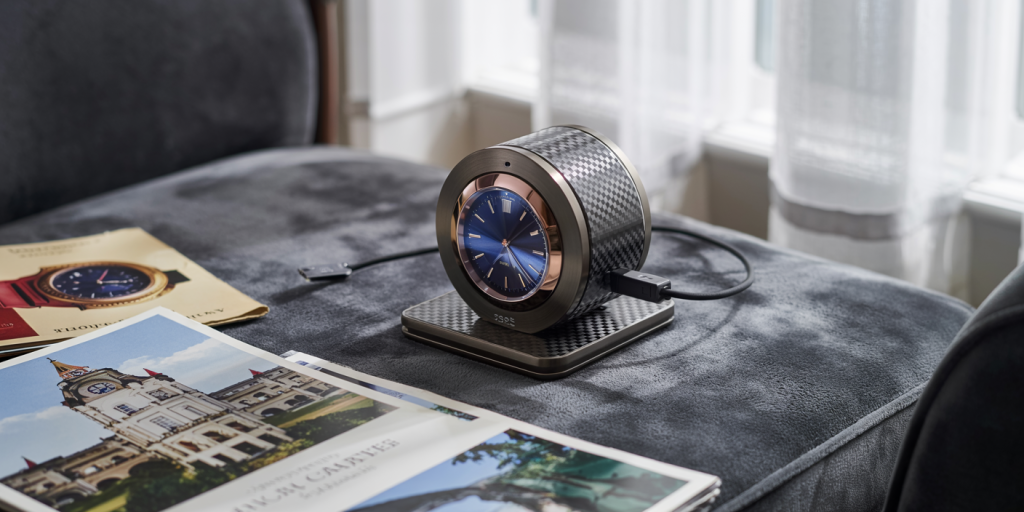
10. Horological Pitfalls: Critical Errors in Timepiece Care (And Countermeasures)
1. Overloading Multi-Slot Devices
- Risk: Jamming multiple pieces into limited spaces strains rotors, causing misalignment or erratic winding patterns.
- Fix: Leave 1cm clearance between each unit; use modular trays for varied case sizes.
2. Disregarding Brand Specifications
- Risk: Exceeding recommended TPD (turns per day) or directionality accelerates mainspring fatigue.
- Fix: Label slots with brand-specific settings (e.g., “Omega: 650 TPD, bidirectional”).
3. Neglecting Servicing Routines
- Risk: Dust accumulation jams bearings; dried lubricants increase motor load by 30%.
- Fix: Quarterly cleanings with compressed air + annual silicone grease application to gears.
4. Compromising on Power Sources
- Risk: Off-brand adapters cause voltage spikes (>12V), frying circuit boards.
- Fix: Use OEM adapters or UL-certified alternatives with surge protection.
5. Overlooking Energy Reserves
- Risk: Depleted batteries reverse-charge, damaging movement lubricants.
- Fix: Smart plugs with auto-shutoff at 20% battery, or opt for solar-powered models.
11. Horological Queries Resolved: Expert Insights
“Can Overwinding Occur with Rotation Devices?”
Modern automatics feature slip clutches to prevent mainspring damage. However, low-quality units may cause magnetization or excessive wear. Opt for TPD-calibrated models matching manufacturer specs.
“Optimal Duration in Rotation Units?”
- Short-term: Leave indefinitely if settings match your timepiece’s power reserve (e.g., 650 TPD for Rolex).
- Long-term: Rotate watches monthly to prevent lubricant settling; perpetual calendars benefit from continuous use.
“Quartz Compatibility?”
Battery-powered pieces gain zero benefit from winders. Exceptions: Seiko Spring Drive hybrids or kinetic models requiring motion.

12. Mastering Horological Excellence: Final Insights
Essentials Revisited
- Precision Preservation: Proper rotation settings prevent lubricant degradation while avoiding overwinding risks.
- Security Protocols: Fireproof/waterproof storage and anti-theft measures safeguard high-value collections.
- Travel Readiness: TSA-compliant portable units with shockproof cases ensure damage-free transit.
Invest in Perpetual Performance
Luxury timepieces deserve engineered care—prioritize winders with:
- OEM-certified motors for silent operation
- Modular trays accommodating diverse case sizes
- Smart power management (e.g., solar/pulse modes)
Join the Conversation
Showcase your setup or seek advice:
- Tag #HorologyHub for expert feedback
- Comment below to discuss niche complications
HOMISAFE: Where innovation meets legacy.



